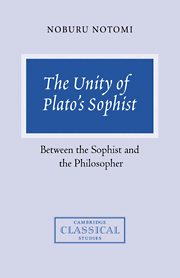Book contents
- Frontmatter
- Dedication
- Contents
- Preface
- Notes and abbreviations
- Division of the Sophist
- 1 How to read the Sophist
- 2 The sophist and the philosopher
- 3 How the sophist appears
- 4 Analysis of the structure of appearance
- 5 Appearance and image
- 6 The sophistic counter-attack on philosophy
- 7 The philosophic defence against sophistry
- 8 The final definition of the sophist
- Bibliography
- Index locorum
- General index
7 - The philosophic defence against sophistry
Published online by Cambridge University Press: 05 June 2014
- Frontmatter
- Dedication
- Contents
- Preface
- Notes and abbreviations
- Division of the Sophist
- 1 How to read the Sophist
- 2 The sophist and the philosopher
- 3 How the sophist appears
- 4 Analysis of the structure of appearance
- 5 Appearance and image
- 6 The sophistic counter-attack on philosophy
- 7 The philosophic defence against sophistry
- 8 The final definition of the sophist
- Bibliography
- Index locorum
- General index
Summary
The philosophic defence in the Middle Part
The previous chapter has shown how the four kinds of difficulty are advanced in the Middle Part by the sophist's counter-attack on the inquirers' attempt to define him. It aims at sweeping away the distinction between the sophist and the philosopher, and so endangers the possibility of philosophy itself. This chapter will in turn show that the argument in the Middle Part as a whole is the inquirers' philosophic defence against the sophistic counter-attack. Its overarching aim is to demonstrate the vital distinction between the philosopher and the sophist, so as to show and secure the possibility of philosophy.
As we have observed in the last chapter, the ‘fighting’ image of the sophist is prevalent in the Middle Part. The sophist counter-attacks the inquirers' statements about appearance without being, image and falsehood, and forces them (anankazein) to contradict themselves. The sophist fights (machesthai, diamachesthai) by putting forward obstacles or problems (problēmata) one after another to the inquirers (260d5–e3, 261a6–b4). The way he fights against the inquirers is to deny the possibility of appearance without being, image, and falsehood altogether, by appealing to the Parmenidean thesis, and consequently to make the distinction between the sophist and the philosopher impossible. Confronting these difficulties, Theaetetus doubts any possibility of capturing the sophist (241c2–3, 261a4–b4), but in response to his doubt, the Eleatic visitor urges him not to give up the investigation (241c4–9, 261b5–c4).
- Type
- Chapter
- Information
- The Unity of Plato's SophistBetween the Sophist and the Philosopher, pp. 205 - 269Publisher: Cambridge University PressPrint publication year: 1999

